MIBS 2015: Ocean Signal, ACR, C-Map, Garmin GNX, Lumitec and Veethree
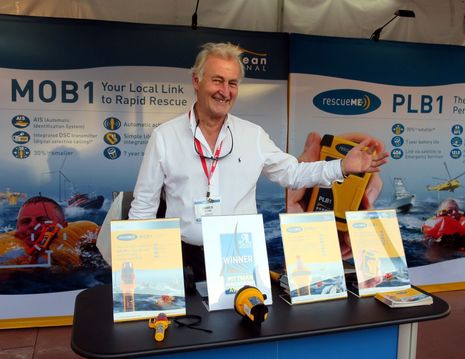 It’s often hard to organize the news from a busy event like the Miami International Boat Show (MIBS), but this year a few of my photos stood out because they also portray the people behind the electronics. So say hello to Ocean Signal co-founder James Flynn, seen here showing off their latest ultra compact rescueME safety devices. The MOB1 personal AIS beacon with its added DSC alarm seems impressively simple to fit and use, and thanks to recent FCC approval, it’s now available here in the USA.
It’s often hard to organize the news from a busy event like the Miami International Boat Show (MIBS), but this year a few of my photos stood out because they also portray the people behind the electronics. So say hello to Ocean Signal co-founder James Flynn, seen here showing off their latest ultra compact rescueME safety devices. The MOB1 personal AIS beacon with its added DSC alarm seems impressively simple to fit and use, and thanks to recent FCC approval, it’s now available here in the USA.
The new Ocean Signal rescueME EPIRB1 also impressed, but the beacon being used in the dramatic simulation above was no doubt well made by ACR, who co-hosted this kickoff “Saved by the Beacon” campaign event with the National Safe Boating Council. I really appreciate the steadfast ability of the COSPAS-SARSAT system and the need for all of us to keep our EPIRB/PLB registrations in order; plus, it was great to have an opportunity to cheer USCG boat and helicopter responders. But several of us noticed that an AIS MOB beacon might have been a better tool for this particular rescue scenario, and I look forward to the day when the SAR community shows more interest in SEND devices like the DeLorme inReach I often carry.
The flares used during the EPIRB demo and later in the dark were new ACR Aurora models that may well become commonplace. The red Aurora Hand Flares will purportedly cost little more than the Orion handhelds most every recreational boat now uses to fulfill USCG requirements, but they are 21 times brighter and seem a lot safer to use. The pull ignitor being shown by ACR marketing director Mikele D’Arcangelo above, for instance, looks a lot friendlier than the striker method. There will also be an Aurora Smoke Flare and yes, these new models seem similar to flares made by ACR sister company PainsWessex but without the SOLAS rating (and higher price). The new flares are not on ACR’s marine product page yet, but you can see Mikele making comparisons here.
The Jeppesen C-Map gang — Roger Brudenell, Francesco Altamura, Ken Cirillo, and James Detar — were a lot more joyful than I was able to photograph. A nearly full implementation of the C-Map 4D cartography suite was looking quite good on all those Raymarine displays, and it can now be yours with the new Lighthouse 13 update. (Note that matching raster charts will come with every vector region — including paper-like Explorer charts of the Bahamas — but Easy Routing and Guardian Alarm are still on the to-do list.) Add Raymarine compatability to the improving quality of Max-N+ charts for Navico MFDs that I saw in Hawk’s Cay and suddenly C-Map is a compelling choice for a whole lot of boaters.
While I think that Jan Silfven was also grinning on the inside, both of us were intent on trying to show how well a Garmin GNX display does its thing in bright Miami sunlight. Jan was part owner of Nexus Marine at one point, then a partner of Dean Barker, and now he seems excited to be part of the Garmin sail performance team in Sweden. He’s also the guy who once showed me how quickly a custom data label could be programmed into a Nexus display — illustration here — and I was happy to learn at the show that Garmin is making that sort of customization easy on the GNX for third party racing developers.
I was tickled to learn that Lumitec founder and CEO John Kujawa has teamed up with several other outstanding engineers on a research project called the innovation boat. For instance, while using simple on/off power switching to put light fixtures into different dim and color modes is common practice, this boat combines that idea with the speed and precision of digital switching (by CZone). The result is a simple interface that can deeply control individual lights on single power circuit while also being light on install expense and hassle. It’s still an experiment, though.
Finally, Veethree Intruments sales engineer Eric Mueller showed me the company’s very interesting new Engine Gateway Monitor, which can put analog and J1939 engine data onto NMEA 2000 networks as well as display it (PDF here). Veethree is the instrument side of Teleflex and they know a lot about engine monitoring. Eric also had a prototype for a black box version of the gateway that will also be flexible and reasonably priced.



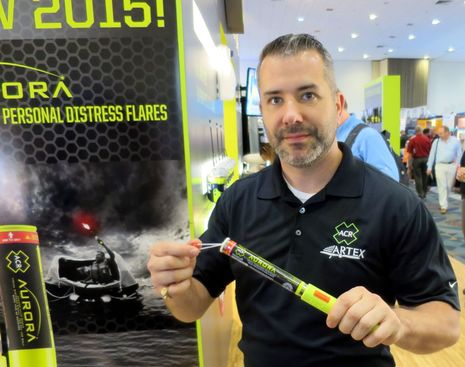
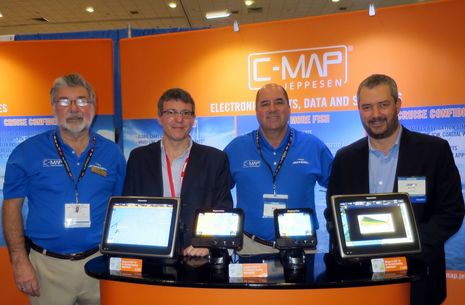
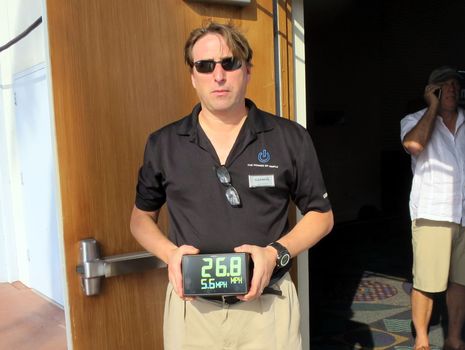
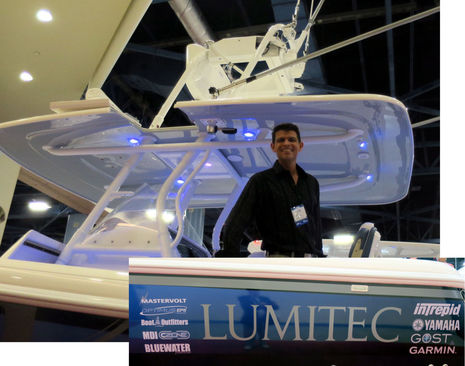

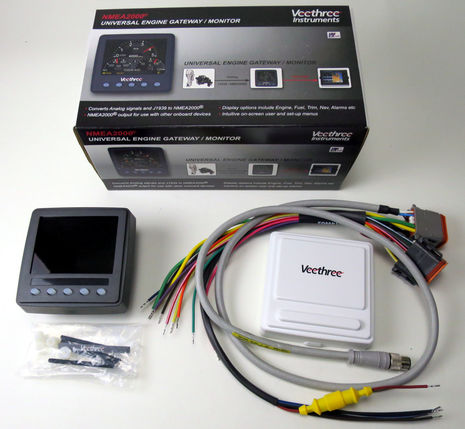
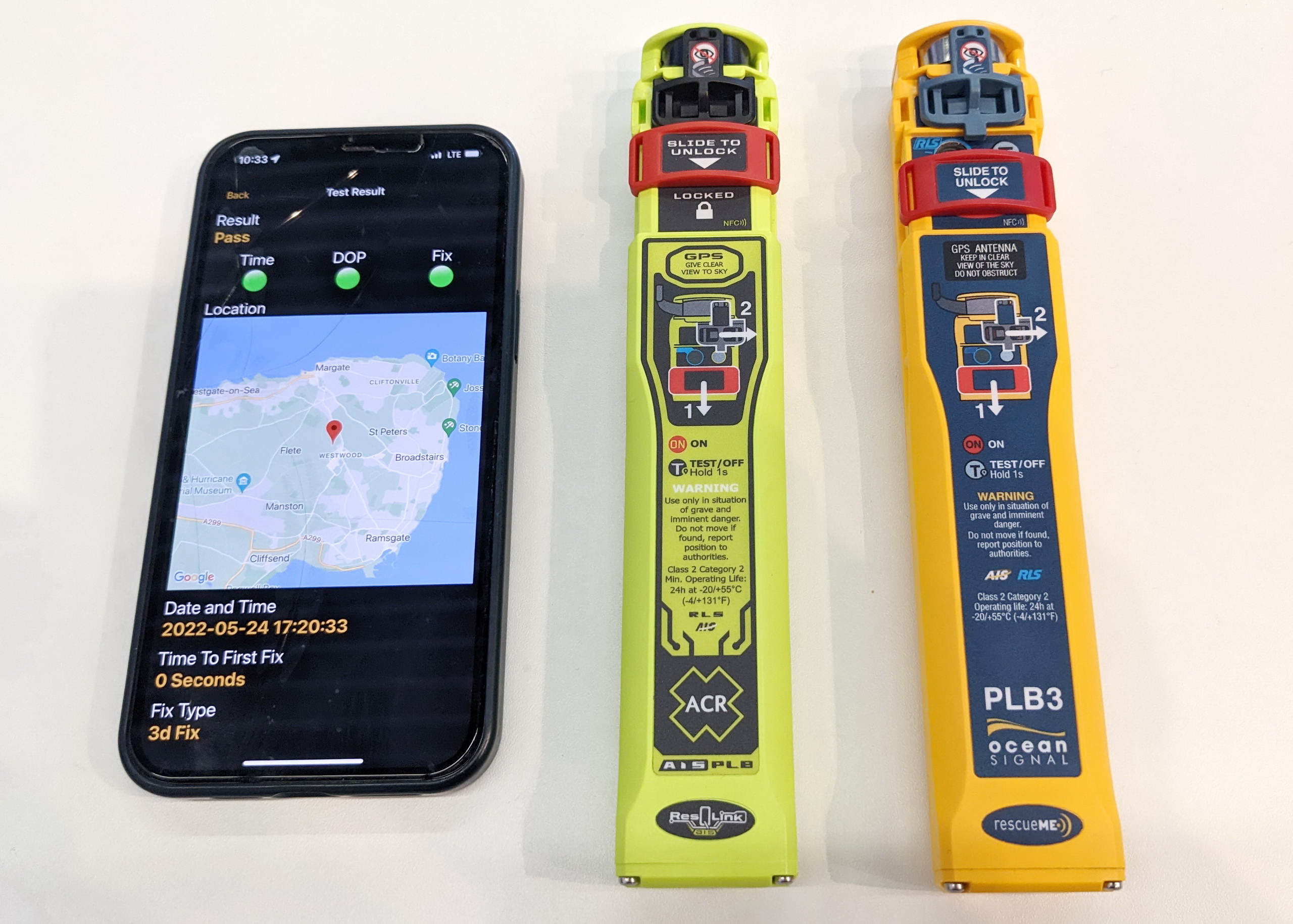
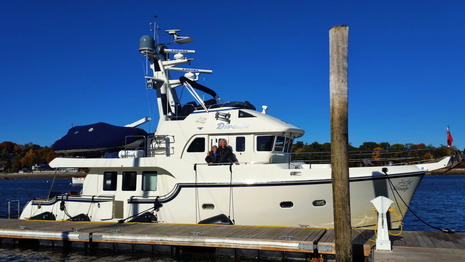
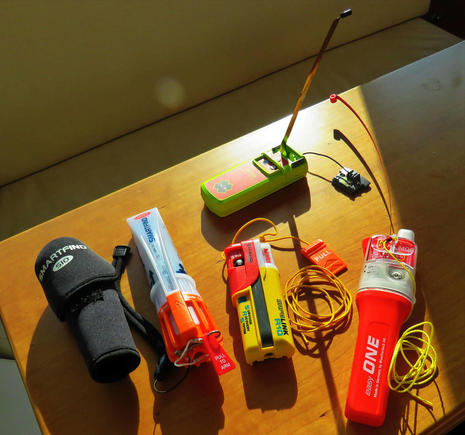







A whole bunch of products at once. Great read Ben.
Are those the kind of flares that don’t drop hot slag, potentially puncturing inflatable RIBS?
That Garmin display is incredibly bright for such low power. Are there fixed segments making each number, or is it a high resolution display that just looks really crisp?
Attn Painewessex, there is a major typo in the word “sale” in the first paragraph.
http://www.painswessex.com/products/solas/red-handflare-mk8
The ACR Aurora Flare details are online now, Dan, and I see this: “Unlike some flares, which emit dangerous sparks and ash, the Aurora’s unique design minimizes emission of smoldering debris.”
http://www.acrartex.com/products/catalog/aurora-distress-signalling-flares/aurora-red-hand-flare
The Garmin GNX displays are actually a three-screen hybrid: segmented on top, pixels in the middle, and a touchscreen control strip on the bottom. The top two seem to be partially transflective, as shown in the photo. More here:
https://panbo.com/archives/2015/01/garmin_gnx_120130_7-_and_10-inch_nmea_2000_instrument_displays.html
Hi Ben,
did ACR mention when the SARLink might get approvals?
http://www.acrartex.com/products/catalog/personal-locator-beacons/sarlink/
Derek
Thanks, Derek. I didn’t even know about the SARLink and it looks very interesting — dual sat systems, dual batteries, touch screen, wow! — though probably high end. They did not mention it during the demo cruise but I’ll ask about status.
Hi Ben,
Do you think by adding the C-Map, that this is a sign Raymarine is moving away from Navionics?
Also, have you seen, or done, any comparisons between Navionics and C-Map??
Valkyrie, I don’t think that any of the plotter manufacturers ever liked being dependent on one electronic chart source, both for their own business reasons and on behalf of their users. I think it’s great that all the manufacturers now support multiple sources (with the exception of Garmin, but they make their own charts, which is great for feature integration, and they license data from C-Map and others). At any rate, Navionics, C-Map and the others don’t have captive markets anymore and I believe it’s good for all.
Comparisons, by the way, are very tough, largely because what you get on the plotter is a combination of data and features provided by the chart company and the display abilities and controls built by the MFD company. The end results also vary regionally according to the HO and private data sources the chart company has access to, and then there’s significant user subjectivity. I happen to like raster charts quite a lot, but some navigators could care less.
Derek, I had to leave the ACR cruise early to get over to the FLIR cruise (by fast boat in the dark ;-), so I missed a presentation on SARlink. But here’s the gist:
“This is one of our next generation military beacons, so it will not be available to the general public for some time. But it combines all the features and benefits of the iridium satellite system including GPS tracking, and 2 way texting (canned or free form) to cell phones, sat phones, the backend messaging center and other SARLinks. Also, SARLink will use the Iridium SOS messaging for 2 way. All of the iridum satellite communications are powered by a rechargeable lithium battery. The combined 406 MHz PLB is built into the device and shares the same GPS data but powers all of the 406 MHz emergency signal bursts from a secondary dedicated lithium battery. The dual battery system ensures that you cannot over use the communication features and leave yourself stranded with an emergency beacon with no battery power left.
No price point of this product yet as it will only be for military purposes at the launch.”
So a four pack of ACR Aurora Red Hand Flares will retail at $38 as compared to Orion at $35. An Orion flare does last 3 minutes versus the Aurora’s one minute, but I think I prefer the shorter burst of 21x candle power, plus the metal body, better ignition system, etc.
I am ready to buy those flares for this season.
Ben,
Another thing to consider when choosing a mapping data supplier is the ease of use of their planning software. I haven’t used the Navionics one, but I’ve used the C-map and the Garmin planning software. There are many differences in the way they each work, their user interface, and the way the handle files. Personally I give the nod to C-map’s PC Planner, but I’m sure that others may prefer Garmin.
Ready to give one arm to get those flares. Though i missed the presentation on SARlink.
Wow! ACR just acquired Ocean Signal, which means it now has one heck of an EPIRB/PLB line plus an outstanding AIS MoB device that will now get wider marketing and distribution.
https://www.acrartex.com/news/press-releases/2015/05/acr-electronics-announces-acquisition-of-ocean-signal
I work at a small chandlery that just started carrying the AIS MOB from Spinlock. My brief research shows that it actually is made by Ocean Signal. Does Ocean Signal also make them for ACR?
As discussed in the review below, I’m fairly certain that the Ocean Signal design team at least helped ACR with its AISLink MOB:
https://panbo.com/testing-ais-mob-beacons-acr-dsc/
But I think that both companies were doing great work even before they became corporate siblings. And note that both are now siblings of UK inflator manufacturer United Moulders. I don’t know if that has to do with the Spinlock version of the OS AIS MOB1, but reliable integration with a life vest’s inflation system is key to automatic activation of these devices, and tricky to design as a universal feature. Having Spinlock offer an AIS Mob specific to their vests is confidence building 😉